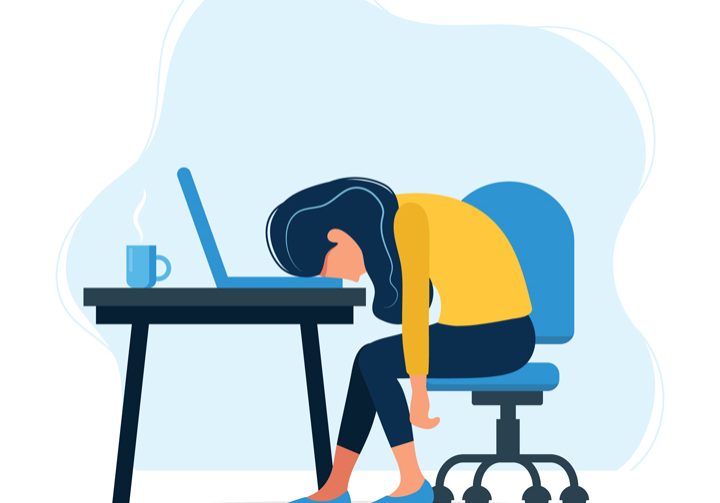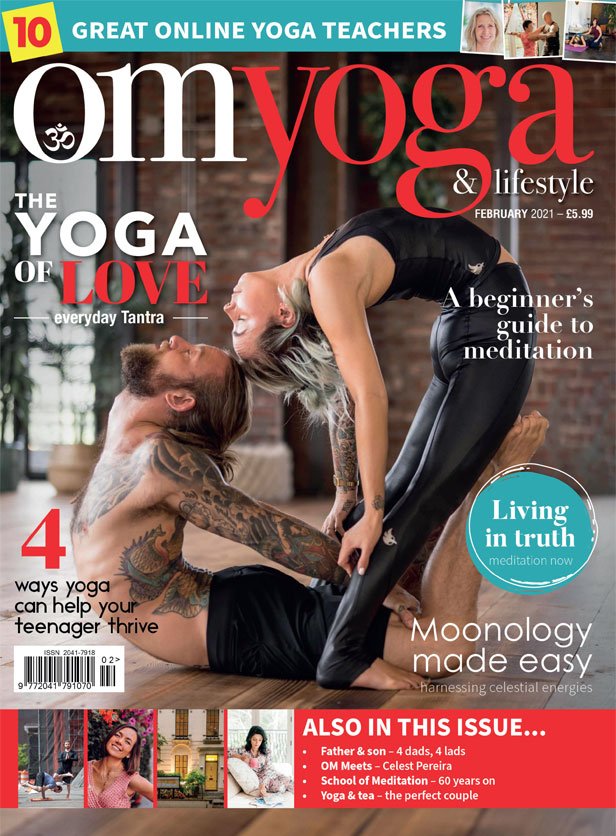
Yoga for burnout
10 ways yoga can heal burnout. By Fiona Agombar
Even the most chilled-out yogi is likely to have experienced stress during 2020. But, now in a new year, can yoga stop us tipping into overwhelm or even burnout?
Stress happens when the body/mind system feels under threat. Our rational brain (the prefrontal cortex) is hijacked as the emotional brain interprets stressors such as fear of losing our job, trying to manage childcare or worrying about falling ill as danger.
This triggers the sympathetic division of the autonomic nervous system (ANS) to release hormones such as cortisol and adrenaline via the fight or flight response. There is no problem if we rest after the emergency has passed, as then our parasympathetic system (the other branch of the ANS) can repair the body.
The problem comes if we don’t give ourselves enough time to recover. Small but frequent bursts of stress eventually cause a chronic arousal, and this may take its toll on our biology, leading to burnout.
Why we need to rest
We live in a society that doesn’t always respect resting or taking breaks. We are expected to be ‘gritty’ or ‘resilient’ — words that describe the characteristics of pushing through, achieving, and being productive.
Concepts like relaxing, taking time out or just stopping have, until recently, been frowned upon. They may even carry a stigma of being lazy, which means we have difficulty in making lifestyle shifts to self-care.
Yet resting frequently is exactly what we need to do if we are to avoid burnout.
How do I know if I’m heading for burnout?
It’s possible the body is still responding in a stress pattern long after the original threat has passed. This is because breathing too fast continues to drive the fight or flight response.
Symptoms of chronic stress include: finding it difficult to switch off from thinking or doing, not being able to relax, panic attacks, general anxiety, insomnia, frequent bursts of irritation, digestion problems, aches and pains from tense muscles and extreme tiredness. Life seems overwhelming.
These are the body’s whispers telling us to slow down. The modern coping method of dealing with stress, however, is to leave the body, of which the smart phone or TV are the ultimate facilitators.
But then we get even more exhausted because we are not embodied enough to process anything. So the emotional discharge of the experience gets stuck in the tissues of the physical being.
Exhaustion and burnout
In 1975, Herbert Freudenberger coined the term ‘burnout’, describing it as emotional exhaustion, loss of empathy, de-personalisation and a feeling of helplessness. The World Health Organisation defines burnout as an occupational phenomenon, not as a medical condition.
I myself have experienced burnout from working as a carer for my husband. I have a friend who also suffers from burnout, she has a child with special needs. So, it really depends on how we define ‘occupation’. The type of financial, emotional and physical support around any situation is also clearly important, whether or not we are working. This is where learning about boundaries and practicing self-care is invaluable.
How do I know if I have burnout?
Symptoms of burnout include exhaustion, poor sleep, flu-like symptoms, difficulty in concentrating, feelings of being detached from everyday life, irritation, anxiety, memory problems, fibromyalgia (from chronic inflammation), depression, irritable bowel syndrome and mental health issues. A feeling of being overwhelmed from daily life is common. Burnout means there is no vitality to manage even small tasks. Many will experience post-exertion fatigue after activity and will only start to recover when they have enough physical, emotional and mental rest. This means that there must be deep relaxation periods every day. The irony is that because burnout causes hyper-arousal to any stimulation, it’s very difficult to help those with this condition to calm down.
Consequently, the appropriate yoga tools that pacify, restore and nourish can play a huge role in healing, although the type of yoga that stimulates will make the situation worse.
What kind of yoga can help recovery?
Relaxation, conscious breathing and slow movement with periods of deep rest and pacing are the most important tools. Chanting is helpful as it primes the vagus nerve, which in turn helps with relaxation. Pranayama can modulate the breath in a way that tells the body that it is safe.
This is done by encouraging a longer, slower exhalation, which breaks the stress cycle by re-patterning the breathing rhythm and teaching the body how to relax and switch off.
Yoga intervention is vital in helping those with burnout to recover, but it must be a practice that focuses on stillness. Excessive activity without rest will actually make things worse, as the body is already drained of its reserves.
What else heals burnout?
Clearly avoiding stress and lowering the sensory load has to be the first step to allow the system to regenerate. Taking time to rest and recharge every day is of vital importance.
In other words, when any stress is less than the capacity of the organism to heal, recovery will happen. But if stress is greater than what the system can handle, recovery will be delayed.
I spent eight years researching my book: ‘Yoga Therapy for Stress, Burnout and Chronic Fatigue Syndrome’ and I’ve set up live online classes for those with burnout, overwhelm, fatigue and ME. These are the things I found that help to heal burnout.
1. Deep rest is vital. There are many free yoga nidra recordings online – practice at least once a day to help the body recover.
2. In a yoga session we rest between postures. Off the mat this translates as taking regular micro-breaks between tasks and not ‘powering through.’
3. A yoga practice should be extremely gentle. Doing too much physical activity is a stressor on the body and will slow down recovery. Movement should be somatic and mindful, feeling into the body and its relationship with the floor and surroundings in the moment.
4. We are mammals so touching and stroking calms the limbic system. We can incorporate this into a practice by bringing the hands to the heart and visualising kindness coming in on each in-breath.
5. Finding a resource is helpful if we are overwhelmed. This could be the connection of the feet on the floor, the softness of the hands or the movement of the breath.
6. Yoga teaches us to surrender, so if a difficult emotion comes up, (unless it is very traumatic) we should allow the emotion to surface whilst bringing acceptance and compassion to the feeling. It’s helpful to have a felt-sense of the emotion in the body rather than in the head.
7. Yoga is mindfulness, which means being here now, fully embodied in the moment. Sense into the physical being whenever you can.
8. People-pleasing and saying ‘yes’ to everything increases our stress load. Yoga teaches us healthy limits as we gain a sense of who we are through our practice. Self-compassion is the root of good boundaries. If we can be kind to ourselves, it’s easier to say ‘no’.
9. Breathing properly is the most important burnout solution. Breathing slowly, through the nose and from the diaphragm will help recovery. Be aware if you have a pattern of hyperventilation, checking your breath regularly throughout the day. Focus on a slightly longer exhalation, which helps to engage the parasympathetic division or chant a mantra as you exhale.
10. Welcome burnout as an opportunity to go deeper into the spiritual side of your practice as there is more time for selfinquiry. Acceptance is key. Acknowledge this is ‘how I am now in this moment and it’s okay’, whilst also knowing that things change all the time.
Yoga Therapy For Stress, Burnout and Chronic Fatigue Syndrome is published by Singing Dragon and is widely available. Fiona Agombar runs online classes for fatigue and burnout twice a week. Find her at: fionaagombar.co.uk


